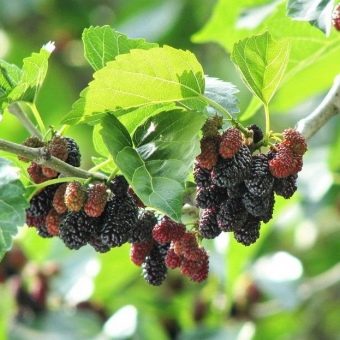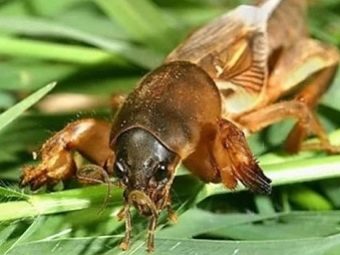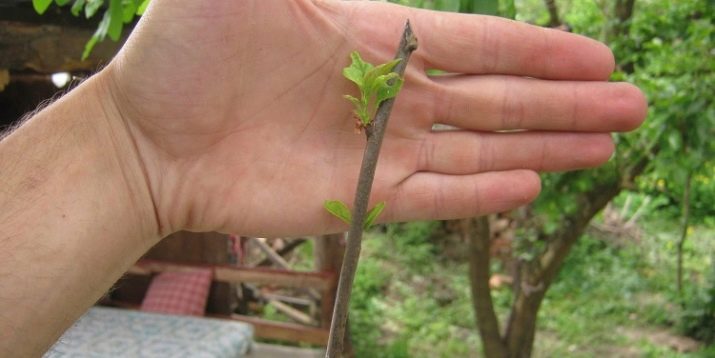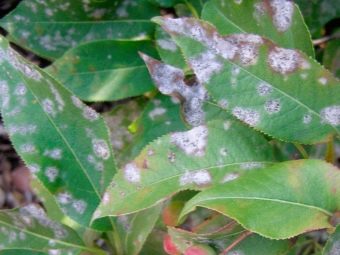How to grow mulberry?
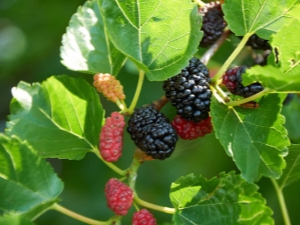
Mulberry grows both in America and in the central regions of Russia. You can also meet her in Africa and even in South America.This plant exists from time immemorial, has a number of useful properties. Fruits contain many trace elements and vitamins. Wood can be a valuable building material. Thanks to the mulberry tree in China, paper and silk appeared 7,000 years ago.
Description and varieties of plants
The mulberry is a monoecious tree, and its flowers are opposite-sex. Leaves are simple or whole. Fruits are juicy, in appearance resemble raspberries, diameter - up to one and a half centimeters. The taste of the berries is pleasant, sweet. She ripens in the second half of June. Berry spoils quickly, after only twelve hours. Mulberry resistant to pests and low temperatures, tolerates drought. After pruning, it is quickly restored. The mulberry tree in the East is called the king-tree. Fruits have a large number of useful compounds, namely:
- various acids of organic origin;
- phosphorus;
- carotene;
- vitamins C, PP;
- set of elements of group B.
Important: in the fruits there are antioxidants that rejuvenate the body and strengthen the immune system.
Fruits can make products such as juices, spirits and vinegar. In China, mulberry from ancient times was used for silkworm breeding. In total there are about two dozen types of mulberry. In Russia, you can find only black, red and white mulberries, it grows in the following regions:
- in Siberia;
- in the Urals;
- in the Leningrad and Pskov regions;
- in central Russia.
Mulberry is a hardy plant, as it is able to withstand thirty degrees of frost, and is not afraid of pruning and molding. The north regions, the more mulberry is found in the form of a bush version. Stag weeping mulberry is a hardy plant that is not afraid of urban pollution, so it is often grown in large cities on streets, boulevards and squares. Among the most popular plants are the following:
- gold
- weeping;
- in the form of a ball;
- with large leaves.
The mulberry tree can bear fruit for up to three hundred years, especially the plants feel comfortable in the southern regions. The color of the wood can be either light yellow or darkish-beige. Fruits can also be different colors. Of the various varieties worth noting the most remarkable.
- "White honey" not afraid of low temperatures, the harvest brings high. The plant is unpretentious to the condition of the soil, the fruits are stored for a short time (the clock goes on).
- Another known variety "Black Baroness". The berries of this mulberry are rather large (3-4 cm). This grade differs in endurance and frost resistance.
- Variety "Vladimir" - This is one of the varieties of mulberry, which has beautiful purple fruits. It does not require special care or pollination, it tolerates pruning well, has exceptional frost resistance. In the regions of Siberia you can find this particular mulberry variety.
- Mulberry "Darkie" grows to 8-10 meters. Crown pyramidal shape. The fruits are large, they can be 2-3 cm in size. The fruit is juicy and tasty. Plants well withstand negative temperatures. The yield is consistently high and this factor contributes to the great popularity of the plant in various regions of Russia. Berries ripen in the first half of July.
- "Hartut" bears fruit in the third year of life. Culture brings high yields. Fruits reach 5 cm, color is black. These fruits are often used in winemaking, as well as in the culinary industry.
- Variety "Fruit-1" gives large-sized fruits that ripen in mid-June. The plant bears fruit for a month, the berries are exceptionally pleasant to the taste. It has a good keeping quality, it can be transported over long distances. The peculiarity is that the fruits become reddish in inclement weather.
- Variety "Merezhevo" appeared thanks to the crossing of white mulberry. Fruiting long (more than a month).Very tasty berries, which, unfortunately, quickly deteriorate.
- Variety "Fruit-4" has a small compact size. It bears fruit well, and the berries are tasty. This variety can be used for commercial needs, because it has a good keeping quality.
- Variety "Shelly" known to many farmers. It has large fruits (more than 5 cm). Harvest can be made in the second half of June. This species is highly decorative.
- "Black Prince" It is considered an elite, it has practically no flaws. This is a very beautiful plant, the berries of which reach a length of 5 cm. The taste is honey, very specific. Fruits can be transported over long distances. The berries are large, ripen in the second half of June. The variety has excellent endurance to the effects of pests and negative temperatures.
- "Ukrainian-6" - this is a very beautiful mulberry, its fruits have an original taste. She has a black color scheme with a matte finish. The size of the berries is 4–5 cm. The fruits are stored for a rather long time - two or three weeks.
Landing
Planting a mulberry tree in the open field is best in the fall and spring. The plant loves small elevations, well lit by the sun, it is not afraid of changes in temperature or the invasion of pests. The most formidable of them is powdery mildew and root rot. And also tinder can bring a lot of trouble. The latter appears quite often on the trunks of trees, feeding on its juices.
Infection occurs during the lesion of the trunk, for example, cracking after severe frosts. If the plant has “picked up” this infection, then it is no longer possible to cure it. And also curly fine graininess is deadly to mulberry. Insects can infect a tree that suck the blood of animals. Brown spotting is another attack that can occur at any time. Often the appearance of this disease is provoked by the following factors:
- nitrogen deficiency;
- lack of the necessary amount of nutrients;
- thick crown.
Of insects, the following can cause great harm:
- larvae of may beetles and butterflies;
- Bears;
- spider mite
Mulberry is an unpretentious plant, because it can do without manured or black earth soils, tolerates drought and negative temperatures. Soils ideal for him are drained loams. Pits for precipitation of the tree are prepared in advance, the ground in them should lie down. The size is an average of 75x75 cm, depth - up to 50 cm. The soil that is removed is mixed with manure. A small layer of gravel, a “pillow,” is placed on the bottom, then the roots of the tree are covered with manure soil, and poured abundantly with water. The distance between the trees is about five meters. Between the bushes leave 3 meters. The soil is mandatory mulch.
Important! Mulberry can be male and female. Male trees do not bear fruit, they are suitable only as ornamental plants.
Care rules
The care of mulberry trees is extremely important. It includes the following steps:
- correct planting;
- weeding;
- digging up the soil;
- regular and regular watering;
- mulching and feeding.
All these measures are necessary so that the mulberry develops normally and does not hurt. Growing a mulberry tree is recommended to be done in compliance with certain canons. After planting, seedlings need to be watered regularly, this is especially important for the first 4-6 weeks of life. Under normal watering, the buds should be fully budded. Pruning a mulberry mullet aims to form the correct shape of the future crown. You can plant a young tree to get the desired shape - this method is also practiced.
Fertilizers should contain such elements as:
- iron;
- zinc;
- magnesium;
- manganese.
It is recommended that chemicals be distributed evenly around the trunk of the tree. From the trunk they should fall apart at a distance of 12 cm.The amount of fertilizer depends on how many mulberry years.
There are special tables that standardize the required quantities of chemicals. A mulberry tree is so vivacious and hardy that it often feels great without additional dressings.
Pruning old and diseased branches is best in the deep autumn. In the summer such an operation is forbidden, because it can adversely affect the crop. If done correctly, the plant (tree or shrub) starts to bear fruit noticeably better. Pruning should be done regularly to prevent necrosis. If cracks appear in the trunk (especially in the hot season) - this is a real threat that the tree will be affected by fungus. If the disease does appear, you should cut the branches 30 centimeters below the affected area. Necrosis is not susceptible to chemicals, so prune affected branches as soon as possible.
Dangerous for the plant is mulberry shchitovka. This is an insect of microscopic size. A large number of them can destroy the plant. Wood is treated with an oily composition. Spraying with insecticides is not recommended, the mulberry shield resistant to that chemical.
Before spraying, you should examine the chemical composition, carefully acquainted with the information on the package. Used oil in a concentration of 2 tablespoons per 5 liters of water.
If the temperature is below +6 degrees, the spraying work should be stopped. It is necessary to process both the foliage and the stem of the plant.
Watering
Mulberry will grow poorly in lowlands, marshy ground and in areas where groundwater come close to the surface of the earth. If summer is abnormally hot, then each plant needs a strait of water once a week. Young trees in the winter must be wrapped. The roots of the plant can suffer from frost (especially in young trees), so it should be carried out with mulching.
On loose soils watered mulberry is recommended twice a week. If the soil is clay, one irrigation per week is sufficient. The tree requires an average of 24 mm of rain per week. Watering should be discarded if the weather is rainy. Water is recommended to be let out under a small pressure, then roots will receive more moisture.
Top dressing
It should seriously think about fertilizer fertilizer, when the mulberry begins to bear fruit. This factor is especially important for plants that grow on sandy soils. In March, as soon as the snow melts the trees are fed with nitrogenous compounds. An average of 50 grams of nitroammophoska is added to one square meter, and a mullein and a little bird droppings are added.
At the beginning of the summer one more feeding is done. It is good to use for these purposes Kemira Universal at the rate of 25 g per square meter. In October, before the onset of cold weather, potash and phosphate compounds are introduced. And also often add ash - 250 g per square meter. Regularly near the tree trunks soil should be loosened. It is recommended to fertilize plants with manure, which is diluted with water 1: 6. In the second half of summer, nitrogenous chemicals are not recommended to be used so that new shoots do not grow.
Pruning
Trees that are only a few years old should be pruned at the top. Thus, it is possible to significantly increase the yield of the plant. The logic is simple - a large number of branches brings a large number of berries. The most hardy in relation to pruning - it is ornamental trees, they can often be pruned in the warm season. It is more rational to make the tree low (up to two meters) so that the branches are unbent, to support them with pruning. A low tree makes it easier to take care of and gather fruit.
Important: excessive pruning can lead to the death of the plant.
Breeding
Multiply mulberry, you can use such methods as:
- seeds;
- root shoots;
- the use of cuttings;
- cuttings.
Propagation by seed is used to obtain a stock of varietal seedlings. Most often, seeds are taken from white mulberries. Before they are planted, they need stratification. After a few years, seedlings can be transplanted, and next year you can already graft mulberry cuttings. Stratification is carried out in the following way: the seeds are placed in a container, which is placed in a refrigerator, where a stable temperature of + 1– + 5 degrees is maintained for four weeks. Next, preparing a place for planting material in the greenhouse. If you plant the seeds in early April, then by October the seedlings will be 50 cm in length.
Propagation using grafts extends to young plants that have reached two meters. And also often create plants that have different varieties on the trunk. Under such circumstances, the tree will be attended by berries of a very different color scheme, the leaves will also differ in color.
From the green cuttings can get own-rooted seedlings, but under normal conditions, it is difficult to do. Most often, professionals use layouts. In this case, a frosted plant is cut to hemp; the following year, the young branches bend down to the ground. That growth, which grows vertically, during a warm season spud more than once, in October, ready saplings are transplanted.
And also for reproduction vaccination is actively used. For rootstock use frost-resistant varieties of mulberry tree, which were grown from seeds. They are removed from the soil and placed in a container with sawdust. There they are stored for some time at a temperature of +1 degree. Grafts are stored at the same temperature. Then the material is placed in containers and kept at a temperature of +24 degrees.
Vaccination can be done from March to April using last year’s material. These may be cuttings that were cut last October. Store this material in the same conditions. Reproduction is also done with the help of "fresh" cuttings in the summer months (June or July). To do this, you can use fresh shoots from 12 cm in length, which are cut in small fragments, the leaves break off. Then they are installed in a tank filled with peat and sand. Indoors, the humidity should be about 100%, sometimes PVC film is used for this.
Preparing for the winter
Every winter, the mulberry “clings” frost thin branches of young shoots. For a mulberry tree, both early frosts and March frosts are dangerous. The latter are dangerous in that they can damage swollen buds, in this case there will be no harvest. When preparing the plant should be a good mulching around the tree trunk. The layer is poured at least 6 cm, usually used sawdust. Spruce fur branches should be put on top of the formed “parapet”. In the second half of October, all thin green twigs should be cut.
Gardeners tips
The following rules should be followed from gardeners:
- too much moisture can damage the development of the tree;
- After trimming, always rinse the instrument with soapy water;
- all bad berries should be disposed of by burning, so as not to provoke the appearance of fungus;
- powdery mildew is effectively eliminated with the help of fungicides;
- It is best to use organic compounds;
- It is not recommended to spray the plants when fruits ripen on it;
- All varieties of trees should be purchased only in specialized farms that have a decent reputation;
- in order to get yields annually, it is better to plant mixed-field mulberries;
- when planting mulberries, one should set about 4.5 meters indentation from other plants;
- In the southern regions, it is possible to plant mulberry in the fall and spring, in the middle zone of Russia, it should be done only in March and April.
For how to plant and care for mulberry, see the following video from the Greensad Garden Center.







